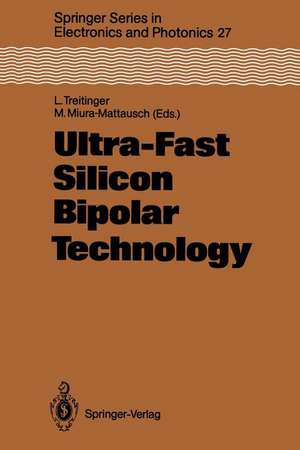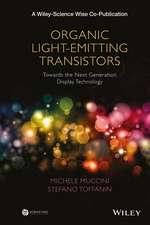Ultra-Fast Silicon Bipolar Technology: Springer Series in Electronics and Photonics, cartea 27
Editat de Ludwig Treitinger, Mitiko Miura-Mattauschen Limba Engleză Paperback – 21 dec 2011
Din seria Springer Series in Electronics and Photonics
-
 Preț: 389.49 lei
Preț: 389.49 lei - 15%
 Preț: 644.18 lei
Preț: 644.18 lei - 15%
 Preț: 653.79 lei
Preț: 653.79 lei - 15%
 Preț: 648.74 lei
Preț: 648.74 lei -
 Preț: 391.02 lei
Preț: 391.02 lei -
 Preț: 393.13 lei
Preț: 393.13 lei - 15%
 Preț: 645.47 lei
Preț: 645.47 lei -
 Preț: 389.11 lei
Preț: 389.11 lei -
 Preț: 380.45 lei
Preț: 380.45 lei -
 Preț: 384.09 lei
Preț: 384.09 lei -
 Preț: 394.29 lei
Preț: 394.29 lei - 15%
 Preț: 643.16 lei
Preț: 643.16 lei - 18%
 Preț: 730.35 lei
Preț: 730.35 lei - 15%
 Preț: 526.35 lei
Preț: 526.35 lei - 15%
 Preț: 638.11 lei
Preț: 638.11 lei -
 Preț: 390.63 lei
Preț: 390.63 lei - 15%
 Preț: 641.03 lei
Preț: 641.03 lei - 15%
 Preț: 637.46 lei
Preț: 637.46 lei -
 Preț: 396.24 lei
Preț: 396.24 lei -
 Preț: 395.09 lei
Preț: 395.09 lei -
 Preț: 395.47 lei
Preț: 395.47 lei - 15%
 Preț: 646.30 lei
Preț: 646.30 lei - 15%
 Preț: 633.35 lei
Preț: 633.35 lei -
 Preț: 383.93 lei
Preț: 383.93 lei - 15%
 Preț: 641.71 lei
Preț: 641.71 lei -
 Preț: 391.99 lei
Preț: 391.99 lei -
 Preț: 395.09 lei
Preț: 395.09 lei -
 Preț: 390.46 lei
Preț: 390.46 lei - 15%
 Preț: 641.53 lei
Preț: 641.53 lei - 15%
 Preț: 642.18 lei
Preț: 642.18 lei - 15%
 Preț: 642.18 lei
Preț: 642.18 lei - 18%
 Preț: 949.23 lei
Preț: 949.23 lei
Preț: 381.81 lei
Nou
Puncte Express: 573
Preț estimativ în valută:
73.06€ • 78.13$ • 60.92£
73.06€ • 78.13$ • 60.92£
Carte tipărită la comandă
Livrare economică 18 aprilie-02 mai
Preluare comenzi: 021 569.72.76
Specificații
ISBN-13: 9783642743627
ISBN-10: 3642743625
Pagini: 184
Ilustrații: IX, 167 p. 16 illus.
Dimensiuni: 155 x 235 x 10 mm
Greutate: 0.27 kg
Ediția:Softcover reprint of the original 1st ed. 1988
Editura: Springer Berlin, Heidelberg
Colecția Springer
Seria Springer Series in Electronics and Photonics
Locul publicării:Berlin, Heidelberg, Germany
ISBN-10: 3642743625
Pagini: 184
Ilustrații: IX, 167 p. 16 illus.
Dimensiuni: 155 x 235 x 10 mm
Greutate: 0.27 kg
Ediția:Softcover reprint of the original 1st ed. 1988
Editura: Springer Berlin, Heidelberg
Colecția Springer
Seria Springer Series in Electronics and Photonics
Locul publicării:Berlin, Heidelberg, Germany
Public țintă
ResearchCuprins
1. History, Present Trends, and Scaling of Silicon Bipolar Technology.- 1.1 Introduction.- 1.2 Polysilicon Emitter Contact.- 1.3 Self-alignment with Polysilicon Layers.- 1.4 Scaling Problems.- 1.5 Heterojunction Transistors.- 1.6 Topical Modelling Problems.- 1.7 Demonstration Circuits.- 1.8 Summary and Prospects.- References.- 2. Self-Aligning Technology for Sub-100nm Deep Base Junction Transistors.- 2.1 Background.- 2.2 Limitations of the Modern Self-Aligned Transistors.- 2.3 BSA Technology.- 2.4 Summary.- References.- 3. Vertical Scaling Considerations for Polysilicon-Emitter Bipolar Transistors.- 3.1 Polysilicon Emitters.- 3.2 Base Charge Control.- 3.3 Transit Time Considerations.- 3.4 Conclusion.- References.- 4. Trench Isolation Schemes for Bipolar Devices: Benefits and Limiting Aspects.- 4.1 Background.- 4.2 Process Technologies and Device Structures (First Generation).- 4.3 Process Technologies and Device Structures (Second Generation).- 4.4 Benefits and Device Performance.- 4.5 Application to Practical Devices.- 4.6 Problems and Limiting Aspects.- 4.7 Conclusion.- References.- 5. A Salicide Base Contact Technology (SCOT) for Use in High Speed Bipolar VLSI.- 5.1 Background.- 5.2 Gate-Speed Simulation.- 5.3 Process and Transistor Design.- 5.4 Gate Speed and Prescaler IC.- 5.5 VSC Masterslice.- 5.6 Conclusion.- References.- 6. Advanced Self-Alignment Technologies and Resulting Structures of High-Speed Bipolar Transistors.- 6.1 Background.- 6.2 SICOS Device Structure.- 6.3 Fabrication Process.- 6.4 Electrical Characteristics.- 6.5 Advanced Process Technology and Electrical Results for High-Speed SICOS Transistors.- 6.6 Conclusions.- References.- 7. Trends in Heterojunction Silicon Bipolar Transistors.- 7.1 Background.- 7.2 Polysilicon Emitter Bipolar Transistors.- 7.3 Epitaxial Emitter Bipolar Transistors.- 7.4 Heterojunction Bipolar Transistors.- 7.5 Conclusions.- References.- 8. Molecular Beam Epitaxy of Silicon-Based Bipolar Structures.- 8.1 Strengths of Si-MBE.- 8.2 Silicon Monolithic Millimeter Wave Integrated Circuits.- 8.3 Si/SiGe-Heterojunction Bipolar Transistors.- 8.4 Conclusions.- References.






